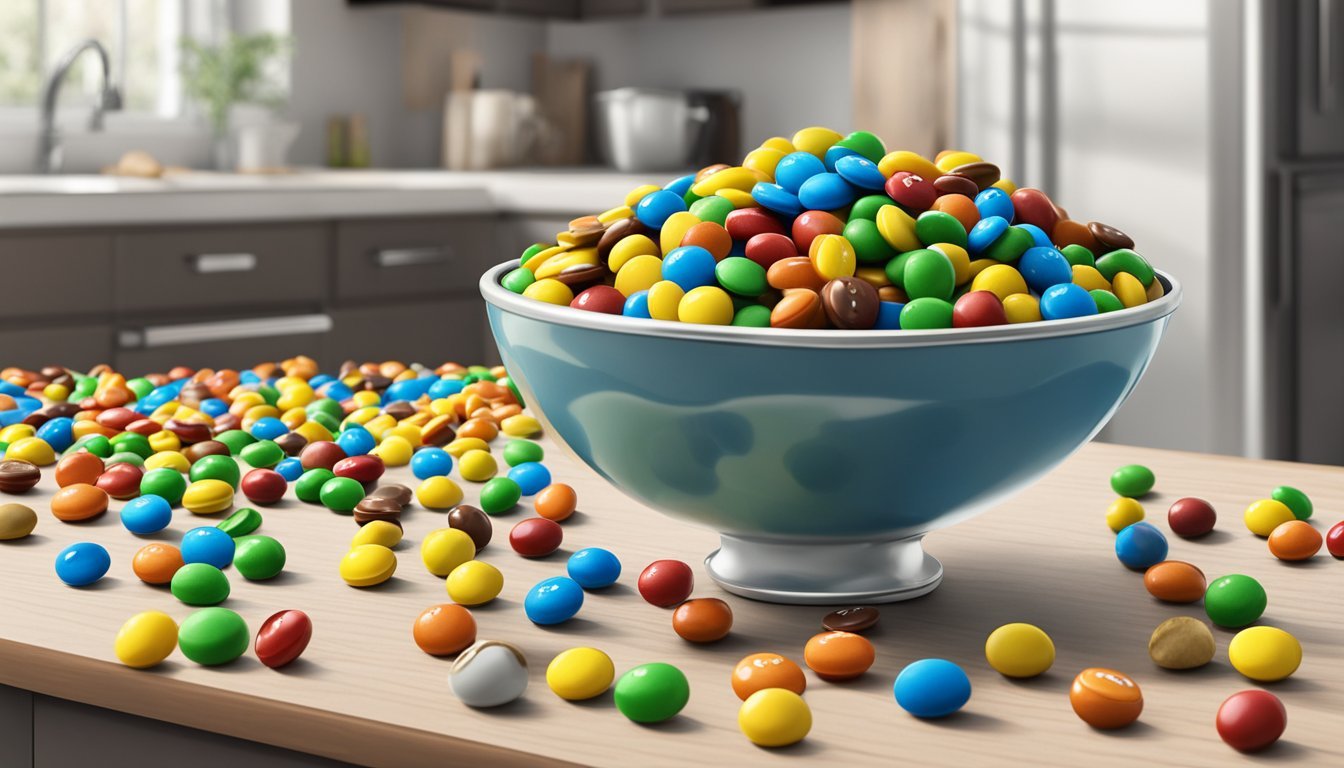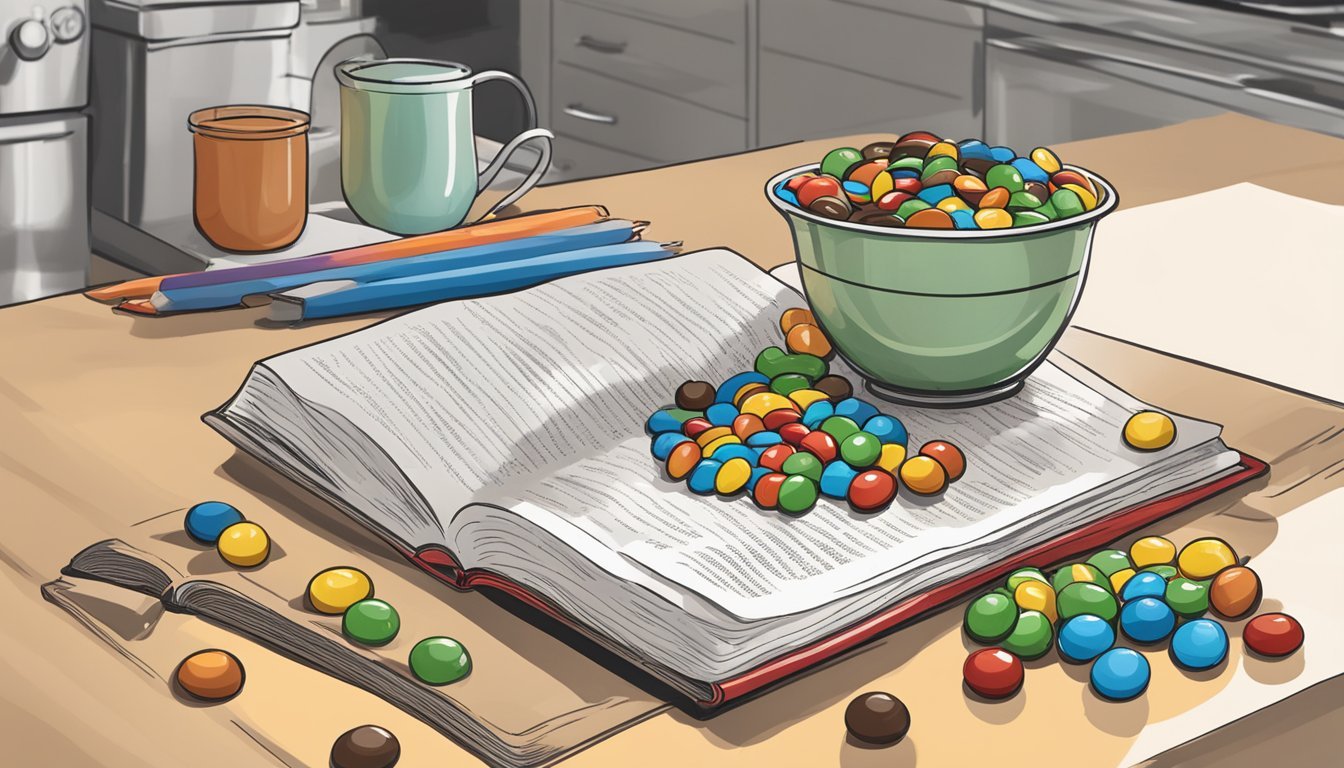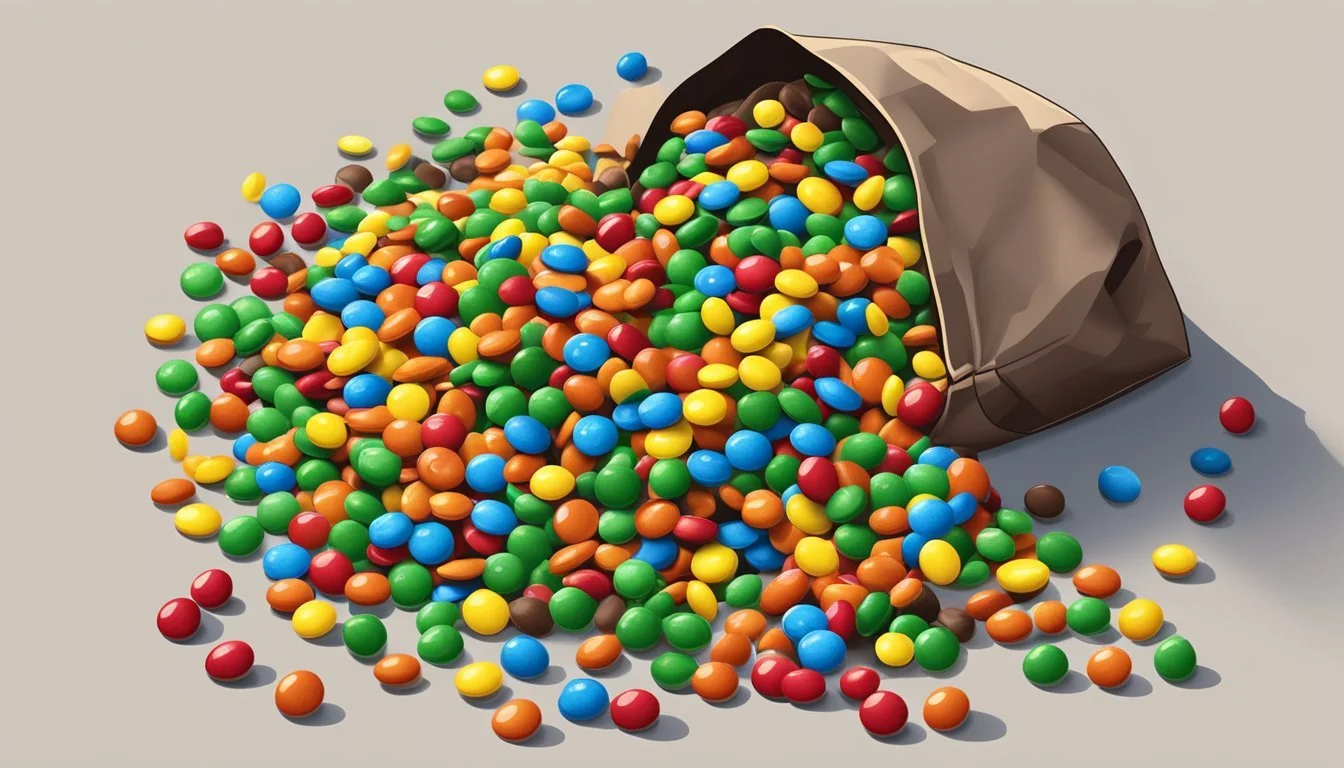How Long Do M&M's Last?
Unveiling the Shelf Life of Your Favorite Candy
M&M's, a staple confectionery loved worldwide, have a notable shelf life that varies based on a range of factors, including the type of M&M's, the storage conditions, and whether the package is opened or unopened. Typically, an unopened pack of standard M&M's can maintain quality for months beyond the "best by" date when stored in a cool, dry place. This longevity is credited to the candy's shell, designed to keep the chocolate (What wine goes well with chocolate?) inside from spoiling quickly.
Variants of M&M's like those with peanuts may offer a slightly different shelf life due to the natural oils and ingredients involved. It is common for M&M's with nuts to last for six months without compromising their taste or texture. Keeping M&M's away from moisture and heat is crucial, as these factors can accelerate the decline in quality. If the package has been opened, consuming the M&M's within a shorter timeframe is recommended to ensure they retain their intended flavor profile.
Overview of M&M's
M&M's are a brand of chocolate candies produced by Mars, Incorporated. Initially introduced to the market in 1941, these small, round candies are renowned for their hard candy shell, which encapsulates a milk chocolate filling. The idea behind M&M's originated to provide a chocolate that wouldn't easily melt, making them a convenient and durable treat.
The M&M's range widely in flavors beyond their classic milk chocolate. They offer an assortment of other types, including:
Peanut: A peanut encased in milk chocolate.
Peanut Butter: A creamy peanut butter core within a chocolate layer.
Mint: Chocolate infused with a mint flavor.
Crispy: Incorporating a crispy rice center with chocolate.
Mars has continuously expanded the M&M's line with seasonal and limited-edition offerings, catering to diverse taste preferences and occasions. M&M's distinctiveness is further marked by the "m" printed on each candy, making it one of the most recognizable products worldwide.
Concerning packaging, M&M's come in various sizes, from small packets suitable for individual consumption to larger bags intended for sharing. The packaging innovation contributes to their shelf life, with vacuum-sealed and hermetically sealed options available to prolong freshness.
With their vibrant colors and array of flavors, M&M's have become more than just a candy; they are an integral part of festive decorations, baking ingredients, and a popular choice for creative crafts. M&M's legacy and continued popularity make them a significant player in the global confectionery market.
Understanding Expiration
When it comes to M&M's, understanding expiration entails grasping the significance of dates indicated on packaging, recognizing shelf life variances, and identifying spoilage. It is critical for both quality and safety.
Expiration Date Concepts
Expiration dates, including best before and manufacturing dates, are indicators of quality rather than safety. The best by date suggests the timeframe in which the candy should retain its optimal quality and flavor. It is important to know that with proper storage, M&M's can last beyond this date without posing immediate health risks.
Shelf Life Details
The shelf life of unopened M&M's typically extends two years beyond the best before date. However, different varieties may have differing lifespans; for instance, M&M Peanuts last about six months, while M&M Mint can last 12 months past the printed date. Proper storage conditions contribute significantly to this longevity.
Signs of Spoilage
Spotting spoilage in M&M's involves observing for changes in texture, flavor, and appearance. Indications such as a whitish coating, which could be fat bloom, or any discoloration suggest the candy may have gone beyond its best quality, though not necessarily bad. It may lose its characteristic crunch and become stale.
Health Risks of Expired Candy
Consuming M&M's past expiration doesn't typically pose severe health risks but can result in an unsatisfactory taste and quality experience. There is minimal risk of candies like M&M's becoming unsafe due to spoilage as chocolates don't develop mold or rot in the same way perishable goods do.
How to Determine if M&M's Have Gone Bad
Quality rather than food safety is the concern for expired M&M's. To assess, inspect for off smells, texture changes, or any discolorations. If the candies have white spots, known as white dots, they may have experienced temperature fluctuations but are generally still safe to consume.
Storage Recommendations
The longevity and quality of M&M's can be greatly influenced by storage conditions. Understanding how to properly store M&M's ensures that their flavors and textures remain as intended for the longest possible time after purchase.
Proper Storage Conditions
M&M's retain their quality best when stored in a cool, dry place such as a pantry or cupboard. It's crucial to keep them away from any heat sources and to avoid drastic temperature changes that can compromise their quality. Ideally, the temperature should be maintained between 60-75°F (15-24°C).
Impact of Temperature on M&M's
One should never store M&M's in environments that are too hot, as the chocolate can melt, affecting their texture and taste. Conversely, although freezing may extend shelf life, it can alter the candy's texture.
Adverse Effects of Light and Moisture
Exposure to light and moisture can diminish M&M's quality. Direct sunlight and high humidity can cause fading or clumping. Hence, storing M&M's away from light and in conditions with low humidity will help maintain their characteristic crunch.
Storage Duration Post-Opening
Once opened, M&M's should be kept in airtight containers to prevent exposure to air, which can accelerate staleness. When properly stored in a sealed container, they can last up to 8 months, though quality may start to decline gradually after opening. It is best to consume them within this time frame for optimal taste and texture.
Consumption Guidelines
When considering the consumption of M&Ms, individuals should be mindful of preservation practices and the candy's condition. The quality and safety of M&Ms vary with time and storage conditions.
Safe Eating Practices
Consumers should store M&Ms in a cool, dry place to maintain their quality. They need to ensure the packaging is sealed tightly if not consumed immediately. Proper storage helps preserve the candy's taste and texture, protecting against humidity and contaminants that could spoil the product. For food safety and hygiene, hands should be clean before handling the sweets.
After the 'Best By' Date
The 'Best By' date on M&Ms packaging indicates when the product is likely to be at its peak quality. It is generally safe to eat M&Ms past this date, but one might notice a decline in taste and texture. As a rule, unopened M&Ms tend to retain quality for several months past the 'Best By' date, while opened packages should ideally be consumed within six to eight months to enjoy their optimal flavor.
Effects of Freezing on Edibility
Freezing M&Ms can extend their shelf life, but may alter their texture, causing them to become soft and sticky upon thawing. While freezing does not make the candy unsafe to eat, it is important to consider whether the changes in texture after freezing might affect one's enjoyment of the product. If one chooses to freeze M&Ms, they should be placed in an airtight container to prevent moisture build-up.
M&M's in Recipes
When integrating M&M's into recipes, the quality and variant of M&M's can significantly influence the outcome of the dish. Bakers often use M&M's to add a pop of color and a distinct chocolatey flavor to their creations, with certain M&M's types more suitable for specific recipes.
Baking with M&M's
In baking, M&M's contribute to both visual appeal and flavor complexity. They are commonly found in cookies and cupcakes, providing a delightful crunch amidst softer textures. When adding M&M's to batter or dough, one should consider their melting point; the candy shell helps to maintain their shape under heat, but high temperatures can still cause melting.
For best results:
Add M&M's to the top of the batter just before baking to prevent color bleeding.
Use a gentle fold to integrate M&M's into the dough to maintain the integrity of the candy shell.
Influence of M&M's Quality on Recipes
The quality of M&M's used in cooking is paramount, as stale or degraded chocolate can distort the intended flavors of a recipe. Fresh M&M's ensure the retention of their signature crunch and flavor, enhancing the overall texture and taste of the dish. The freshness of M&M's can be ascertained by the brightness of their candy shell and the firmness of the chocolate within.
Checking Quality:
Examine the candy shell for any dullness or flaking.
Press gently to test the firmness of the chocolate center.
Recommended M&M's Variants for Cooking
Different flavors of M&M's can complement various recipes. Milk chocolate M&M's are a classic choice, known for their universality in baking. Dark chocolate M&M's offer a richer taste, suitable for those who enjoy a bitter contrast. For distinct flavored baked goods, such as mint chocolate cookies, mint M&M's can be used for that extra burst of flavor. Peanut butter M&M's work well in recipes that benefit from a creamy, nutty addition, while plain M&M's are best for those who desire the essential M&M's experience with the signature candy shell.
Flavor Pairings for Recipes:
Milk Chocolate: Ideal for traditional cookies and cupcakes.
Dark Chocolate: Best paired with recipes calling for a depth of chocolate flavor.
Mint: Suggested for mint-themed desserts or to add a refreshing kick.
Peanut Butter: Used to enrich the flavor profile of a dish, especially if peanut butter is a key ingredient.
Plain: Suitable for all types of baking, providing the classic M&M's taste and texture.
Miscellaneous Concerns
When considering the longevity and quality of M&M's, several lesser-known but important factors come into play. These not only affect how M&M's are stored and when they should be consumed but also encompass historical and branding elements that contribute to their overall perception and usage.
Unusual Changes to M&M's
M&M's are resilient to spoilage, but they can undergo undesirable changes. Discoloration, such as white spots on their coating, indicates they are drying out and should not be consumed for optimal taste. Texture changes, like hardening or stickiness, often suggest that M&M's have been exposed to moisture or sunlight. While these conditions may not pose direct food safety concerns, they do affect the flavor and quality of the product.
Nutritional Considerations
Regarding nutrition, M&M's contain sugar, milk, and, in some variations, nuts. Although these ingredients provide energy, they also translate into calories. Consistent with recommendations by health organizations, one should regard M&M's as a treat rather than a dietary staple due to their high sugar content and presence of saturated fats from milk.
Historical Aspects of M&M's
M&M's have a storied past that dates back to World War II, when the need for stable chocolate rations for soldiers drove their creation by the Mars Company. Their design was intended to prevent melting and ensure longevity, which is why properly stored M&M's can last quite a long time even by today’s standards.
Brand Information
M&M's are produced by the Mars Company, a significant competitor to Hershey. Information about product quality, shelf life, and nutrition can be found on both the Mars and Hershey website for their respective products. Proper storage, including keeping the candies away from sunlight and moisture helps maintain their characteristic candy shell and the integrity of the coating.
Frequently Asked Questions
When it comes to the longevity and freshness of M&M's, consumers often have pertinent questions regarding their safety and how to maintain their quality over time.
Are Expired M&M's Safe?
Expired M&M's are generally safe to eat, although their quality might not be optimal. The flavor and texture can degrade after their best by date, but they do not become unsafe to eat unless they show signs of spoilage such as an off smell, taste, or visible mold. It's important to ensure they have been stored properly.
Optimal Conditions for Preserving Freshness
For maintaining M&M's freshness, store them in an airtight container in a cool, dry place. Keeping them away from direct sunlight and moisture extends their quality and shelf life. Ideally, unopened packs last up to two years, and once opened, one should consume them within six months to enjoy their best quality.
Can You Freeze M&M's for Extended Shelf Life?
Freezing M&M's can extend their shelf life. To freeze them, place M&M's in a sealable bag or an airtight container to prevent moisture and freezer burn. They can remain in the freezer for an extended period, but it is vital to remember that while freezing can preserve their safety, it may affect their texture upon thawing.









